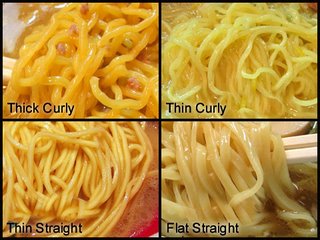Ramen Basics - The Noodles
The noodles commonly used in Japanese ramen are made with wheat noodles and eggs. They can be round and come in a variety of thicknesses or occasionally can be flat as well. I will talk aobut ramen noodles by breaking down the topic into three areas: the ramen noodles' ingredients, thickness and texture.
The Ingredients - are flour, eggs, and water. But from these three ingredients are numerous possible combinations to create just the right ramen noodles. The flour that is most commonly used are a high gluten bread flour milled from hard wheat, which contains a higher percentage of protein. High gluten flour is more elastic than regular wheat flour, giving the noodles a chewier texture. The eggs are added to hold together the flour together, with the egg white's protein adding more springiness to the noodles while the egg yolk gives it a natural yellowish color. The water can sometimes be alkaline water with sodium carbonate or potassium carbonate. The Alkaline water adds elasticity and flavor to the ramen noodles, though some places prefer to only rely on the eggs to provide the texture and flavor.
The Thickness - the noodles are all long and thin, but how "thin" is what's important here. A thick noodle is anything wider than 1.8mm, while a thin noodle is aroun 1.15mm wide. Hakata style tonkotsu ramen are famous for using thin noodles at around 1.1mm thickness. Some Japanese noodles are slightly curly, where the noodles are pressed slightly perpendicular to the length of the noodles. This adds more texture to the noodles, it also makes the noodle intertwine with the soup more when eaten with chopsticks.

The Texture - is a result of the ingredients, the kneading of the dough, and the length of boiling them.. Some ramen noodles use less water, which results in a dough that is harder to knead, the noodles also absorbs the soup faster and can be overcooked more easily. Some ramen noodles uses more water and have more springiness to them. The length of time for boiling the noodles can also come in different extremes. Some ramen places are famous for boiling their ramen for no more than a few second, resulting in a ramen that is very hard and chewy.
There really isn't one type of ramen noodle that is the best, each ramen has its own taste, shape and texture that matches best with the soup.


0 Comments:
Post a Comment
<< Home